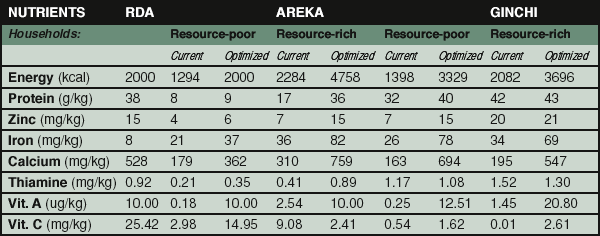







 |
 |

Understanding Systems
An agricultural system is an integrated unit of production encompassing diverse system components (crops, livestock, soil, trees, water) and their interactions, which are in turn influenced by decisions shaped by farmer goals and constraints (financial, human and natural resources). A system may also be viewed from a landscape perspective, encompassing diverse farms and other landscape units (springs, common property resources, infrastructure) and their interactions. AHI uses a "systems approach" to understand and address livelihood and natural resource management problems. This is understood as a holistic approach to addressing identified constraints through appropriate technologies, practices and institutions in a way that balances attention to diverse system components, land users and goals (income, agricultural productivity, natural resource management, equity, risk reduction).

Boosting human nutrition through land use modeling: Household nutrient budgets at Areka and Ginchi before and after optimization help to distill nutritional implications of system-wide changes in land allocation.
 |
The attention given by researchers, research organizations and extension to disciplinary perspectives and approaches presents a challenge to systems research and development. Researchers and extension agents require a better understanding of the causal linkages between different systems components, users and goals—thereby enhancing awareness of farmer decision-making processes and the trade-offs of different options. The tendency of researchers to focus on few variables of assumed importance (i.e. grain yield) rather than looking at multiple variables of interest to farmers or to diverse goals (i.e. grain yield for income/food security, plant biomass for livestock productivity, soil fertility impacts for sustainability) undermines the relevance of researcher expertise and interventions. To understand systems better, we need to learn to listen better (what goals and variables are of interest to the actual decision-makers?), to translate these listening skills into the way research is defined (objectives, variables, outputs) and to generate research findings that clarify and quantify the trade-offs of a diversity of alternatives.
To address these challenges, AHI has promoted changes not only in research methods, but in researchers' and development actors' "mind sets." This has included infusing a systems orientation into biophysical research and greater attention to non-biophysical dimensions of farmer decision-making, seeking to optimize returns to multiple goals or outputs. This is sought to be achieved by strategic combinations of complementary technologies and interventions (technological, social and institutional), a shift to farmer-centred and managed research, and a shift in the researchers' role toward monitoring farmer-driven innovation, contextualizing the information for a wider range of users, and taking up second generation research issues in response to challenges farmers encounter throughout the innovation process.
 |
 |